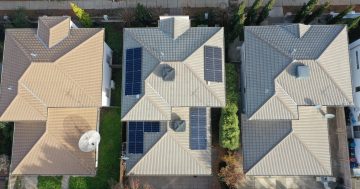[First filed: September 03, 2008 @ 08:26]

Just noticed this new addition to the CMD [Chief Minister’s Department] website: Solar Power Plant Pre-feasibility Study
Gas power station, data centre, now a field of solar rays – got to dump something on the north side of the city I suppose. Maybe the old radar station site.
Just when you thought the October election was going to be a bore!
[ED – And the Chief Minister’s media release on the subject is now online. They’ll need a stonking 120 hectare plant to power just 10,000 homes according to the Study. The image is of the site in Nevada which is named as the inspiration for the proposed ACT plant]
UPDATED: Jonathon Reynolds notes that a gas fired power station appears to be part of the plan for this development too.
ANOTHER UPDATE: Having thought about it all day Zed has responded incredulously to the chutzpah of another power station being announced.
- “Given the crisis that Stanhopes last power station venture caused, I am not sure that the Canberra community trusts this Government to build any major project.
“The Canberra Liberals are supportive of seeking new ways and increasing investment in renewable energy. The concept of a solar farm is well worth considering; however, neither we, nor the Canberra community, know what technology will be involved, where the station will be located, and how much exactly it will cost.”
Zed also thinks the proposal is light on detail, so we look forward to his next in-depth policy announcement.





















